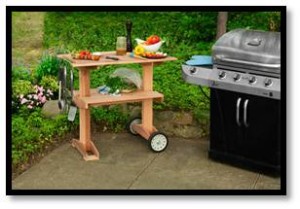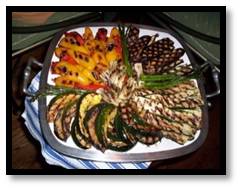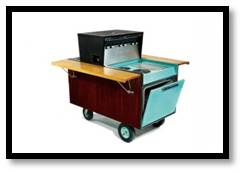Monday Author: Susanne Skinner
 The summer garden has arrived, and with it my summer kitchen. It makes sense to eat lighter in the summer and once the heat goes up outside, I don’t want heat from the oven on the inside. I move the kitchen outdoors. Nothing fancy—just a grill with a table and chairs—but a much different (and easier) approach to cooking and eating. In my next life I want a pimped-out grilling and chilling center with a deck the size of Rhode Island but for now the back patio will do.
The summer garden has arrived, and with it my summer kitchen. It makes sense to eat lighter in the summer and once the heat goes up outside, I don’t want heat from the oven on the inside. I move the kitchen outdoors. Nothing fancy—just a grill with a table and chairs—but a much different (and easier) approach to cooking and eating. In my next life I want a pimped-out grilling and chilling center with a deck the size of Rhode Island but for now the back patio will do.
One hundred and fifty years ago, before widespread electricity, many people had summer kitchens for practical reasons. Stoves were cumbersome; taking forever to heat up and cool down. If you could afford it, you moved it to a building outside the main house. When the heat of summer arrived, the summer kitchen was in a purpose-built structure that housed a wood burning stove for canning, preserving and processing what would be stored and eaten when the cold weather arrived.
After World War II, a new summer cooking trend appeared and became known as the barbeque. It was a big deal in the ‘burbs and companies like General Electric created a special appliance to showcase this outdoor cooking revolution. They called it the Partio. It had a range, oven, rotisserie and charcoal BBQ and sold for $800 in 1960. Deluxe models included an umbrella. Refurbished ones sell for as much as $10,000 today. It’s a party on wheels.
‘Tis the Season
We have a defined summer here in New England. Some years are better than others, but on average we enjoy about four months of decent weather and if we’re lucky a bit of Indian summer.
Our garden is planted with vegetables and lots of herbs. It’s just the two of us now so we’ve scaled back considerably but picking fresh tomatoes and inhaling the scent of basil on a warm afternoon is a summer joy. We also have local farm stands that compensate for the smaller vegetable garden and we enjoy their bounty throughout the summer and into the fall, when we head for the apple orchard.
Buying produce fresh from the farm is something I look forward to. Local lettuces, corn, squashes and peppers are more flavorful and a meal unto themselves. Add some chicken or pork and dinner is served. Cook extra and it’s also lunch.
Fresh vegetables don’t require much in the way of seasoning but I love a good balsamic drizzle and can’t say enough about Cavenders, my new favorite all-purpose salt-free seasoning. America’s Test Kitchen recently reviewed supermarket balsamic vinegars and their top recommendation is Bertolli Balsamic Vinegar of Modena. Get some.
When you’re grilling a good olive oil is your friend and there are a wide range of prices and distinctive flavors. Columela Extra Virgin Olive Oil from Spain gets very high marks from America’s Test Kitchen, but it’s pricey. I save that one for dunking and drizzling. There are many good and reasonably priced choices out there, so find a flavor and price range that work for you.
Cook Once, Eat Twice
Grilling your food adds a dimension of flavor to meats and vegetables that can’t be had from the oven or stove top. It is part science and part skill. Anyone can cook on a stove top, but the grill demands patience and attention. Doneness means different things to different people. Know your meat temperatures and you will always get it right. Checking doneness is easy with my favorite cooking and baking tool, the Thermapen instant-read thermometer.
 When I am cooking in the summer kitchen it’s easy to prepare extra servings for a second meal. Grilled meats and veggies are just as good cold. If we’re grilling fresh corn I throw on a few extra ears and remove the kernels to use in this salad, along with tomatoes from the garden. I am the envy of my office when I bring it for lunch.
When I am cooking in the summer kitchen it’s easy to prepare extra servings for a second meal. Grilled meats and veggies are just as good cold. If we’re grilling fresh corn I throw on a few extra ears and remove the kernels to use in this salad, along with tomatoes from the garden. I am the envy of my office when I bring it for lunch.
Everyone’s least favorite chore is cleaning the grill and I’m right there with you. Two words—disposable pans—become our salvation. These come in just about any size, and I get them at a local discount store. Slow cooked ribs and my husband’s special pulled pork can spend hours on the grill without the major clean up that ensues. We have been known to siphon off a bit of the rendered and seasoned fat from the pulled pork and use it to roast potatoes. Once you’ve tried it, there is no other way.
I poke holes in a flat aluminum tray for veggies like beans and asparagus that might otherwise slip through the grate. For a delicate piece of fish, old fashioned aluminum foil does the trick. Speaking of fish, salad nicoise is a summer favorite. I substitute the canned tuna in this recipe for freshly grilled tuna or salmon cooked earlier in the week. Build your favorite version of a salad, but use the dressing in the recipe for authenticity.
Even dessert can be done on the grill. If you haven’t indulged in grilled fruit get some peaches or pineapple and make sure you have good vanilla ice cream in the freezer.
Keep it Simple
A summer kitchen invites you to keep things unpretentious. The most compelling reason for cooking outdoors is simplicity. Very few rules and tools are required and the cooking is done in one place.
The second most compelling reasons are freshness and flavor. Fresh food demands very little from us to be flavorful and healthy. Marinades and rubs transform the blandest of foods once they are placed on a grill. It’s hard to pinpoint exactly why the smell of grilling food appeals to us, but a burger on the grill still beats any other kind. You can taste the heat and smoke, and it brings a new dimension to just about everything you cook.
Spend your summer in the summer kitchen. Inspiration abounds, possibilities are endless, and results are delicious!

